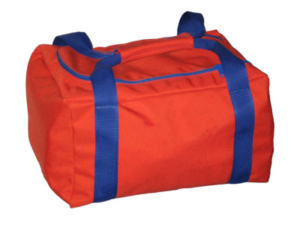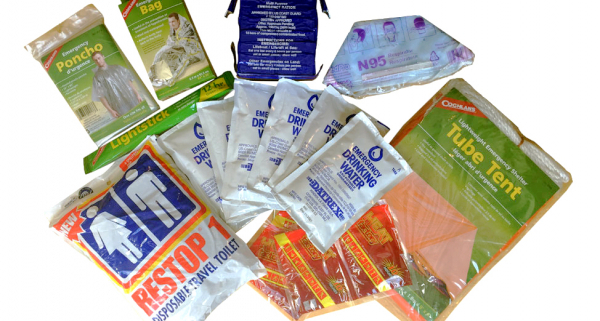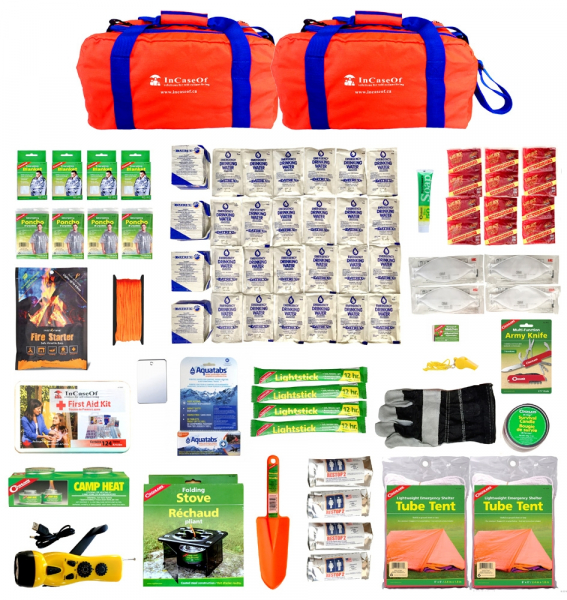72-Hour Kits: Your Best Friend in a Jam
 The Role of 72-Hour Kits
The Role of 72-Hour Kits
What exactly are 72-hour kits, and why are they so important? They can also be referred to as “bug out kits” or “grab-and-go bags”. These kits are carefully assembled collections of items designed to sustain you and your family for up to 72 hours in the event of an emergency. But why 72 hours, you ask?
The 72-hour timeframe is not arbitrary; it’s based on the idea that during the initial aftermath of an emergency or disaster, it can take up to three days for first responders and relief agencies to establish order, set up logistics and provide assistance. In those hours, your 72-hour kit can become your lifeline, ensuring you have the necessary supplies to weather the storm, both figuratively and literally.
Example: Imagine a situation where a major storm knocks out power and makes roads impassable in your neighborhood. In such scenarios, your 72-hour kit offers a sense of security and self-reliance. It provides you with shelter, sustenance, and the tools needed to address immediate medical concerns. In essence, it’s your insurance policy for a smoother transition through the initial phases of an emergency.
Who Needs One?
Now, let’s address a common question: “Who should have a 72-hour kit?” The answer is remarkably straightforward: everyone should. Emergencies are indiscriminate; they don’t differentiate between urban, suburban, or rural settings, nor do they consider one’s occupation or lifestyle. In essence, these kits serve as a safety net, a wise investment in your well-being regardless of where you reside or your daily routines.
Customizing Your Kit
Think about your unique family. If you have infants or elderly family members, consider specialized supplies like baby formula or prescription medications. Those with food allergies or medical conditions might require specific items in their kits to help out with individual situations.
- Food: When it comes to food, opt
 for non-perishable items like canned goods (don’t forget the can opener!), energy bars, emergency ration bars, or dried fruits. Remember, these should be items you and your family are willing to eat. So test things out before hand. Example: hand a ration bar around the table before supper one night and take everyone’s feedback.
for non-perishable items like canned goods (don’t forget the can opener!), energy bars, emergency ration bars, or dried fruits. Remember, these should be items you and your family are willing to eat. So test things out before hand. Example: hand a ration bar around the table before supper one night and take everyone’s feedback. - Water: You want to aim for a minimum 1200 calories per day per person. Ensure your kit contains emergency water rations per person. Then pack water extender items, such as a portable stove to boil water, a pack of water purification tablets, and items such as a LifeStraw water filtration straw or a fully portable water filtration system to extend your ability to create further safe drinking water.
PRO TIP: Remember, this is not a ‘holiday in paradise’ packing list – you will not be able to pack everything you would normally like to eat and drink for 72 hours in a survival kit. You might be thinking, “how can I have all this in a grab and go kit?” The reality is you cannot have everything. Your packing here for survival in an emergency situation. The goal is to get through it, not enjoy restaurant quality steak every night.
- Clothing and Gear: Depending on your climate, pack appropriate clothing and footwear. Don’t forget essentials like blankets (like compact emergency bags), gloves, hats and sturdy shoes. A reliable multi-tool or Swiss Army knife can be invaluable.
I have three children (all boys), and keeping them in the right size clothes is challenging. My 72 hour kit focuses on having underwear and socks, and a couple too-big t-shirts (better than too small I think!), plus toothbrushes, toothpaste, deodorant and a pack of wipes. In a grab-and-go pinch I personally like the idea of having fresh underwear daily (maybe that’s just me?) for everyone, even if they do not have clean pants daily! It’s the little things right?
Customizing Continued:
- Communication: Include a battery-powered radio or a hand-crank model to stay informed.
- Lighting: Flashlights with extra batteries, candles, and waterproof matches are also idea for providing light during power outages.
- Documents: Make copies of essential documents like IDs, passports, and insurance policies and put them in the kit today!
- Cash and Spare Keys: Stash some cash in small denominations. You never know when ATMs might be inaccessible. Spare keys to your home and vehicles can also be handy.
- Entertainment: Maintaining morale by including some form of entertainment like a deck of cards or a favorite book. A pair of dice can provide plenty of fun with a little imagination.
- Pets: Don’t forget your furry family members. Ensure you have their 72 hour kit with some food, water, leashes, and any necessary medications. Their comfort and well-being matter too – especially in an emergency. You don’t want to have to split your ration with your puppy when you are both starving.
Want to save your time? We done all the research and have created some meticulously curated 72 Hour Kits to choose from! Check out these 2 or 4 person deluxe kits, and these 2 or 4 person basic kits. We also have upgrade kits to adapt the kit for additional family members.
Maintaining and Updating Your Kit
Having a well-prepared 72-hour kit is fantastic, but it’s not a set-it-and-forget-it situation. Regular maintenance is key to ensuring your kit remains reliable.
Expiration Dates: Check the expiration dates on food and medication. This ensures your supplies are safe to consume when an emergency arises.
Rotation: Periodically rotate food items and batteries to prevent them from becoming unusable. A good rule of thumb is to review your kit yearly or when the seasons change (winter to summer, summer to winter).
Seasonal Adjustments: Be mindful of the changing seasons. Swap out clothing and gear as needed to match the weather conditions. If you live in an area with harsh winters, consider including items like hand warmers and thermal blankets. Have clothing and gear lists based on the seasons to allow for ease of adjusting your kit. Or if possible, create a winter add-on kit that sits beside your 72 hour kit, that you would only need to grab in that season.
Accessibility: Ensure your kit is easily accessible. Everyone in your household should know where it’s stored, and it should be within quick reach. If you have multiple family members, you might even consider creating individual kits for each person. Use the opportunity to teach the children how to manage their own kits.
Training: Familiarize yourself and your family with the contents of your kit. Know how to use items like the first aid supplies and the hand-crank radio. Practice your emergency plan regularly to ensure everyone knows what to do in case of an evacuation. You can have some really funny family nights going through your kit.
Sample 72 Hour Kit Checklist
*This can be part of your shelter-at-home storage, or have a grab and go plan.
Water:
- Three gallons per person (1 gallon per day)
- Hauling that much water in a grab and go emergency is not necessarily realistic. This would be an opportunity to make a plan based on various scenarios that could occur. Ex: Suzy’s job is to grab as much of the stored water jugs as possible before departure. Or, every kit contains a life straw and water purification tablets, knowing that your evacuation destination is near a river.
- Water purification tablets or a portable filter
Food:
- Canned goods (soup, veggies, fruits)
- Energy bars or granola bars
- Emergency ration bars
- Dried fruits and nuts
- Peanut or almond butter
- Canned tuna or chicken
- Ready-to-eat meals (MREs or freeze-dried)
- Instant oatmeal or cereal
First Aid:
- First aid kit with bandages, antiseptic wipes, and tape
- Prescription meds (if needed)
- Pain relievers (e.g., aspirin, ibuprofen)
- Tweezers, scissors, thermometer
- Specific personal medical supplies or equipment
Shelter/Warmth:
- Blankets or sleeping bags or emergency blankets (for space)
- Warm clothing (layers)
- Rain poncho or waterproof jacket
- Tarp or emergency shelter
- Hand warmers
Communication:
- Battery-powered/hand-crank radio
- Extra batteries/phone charger/power bank
- Whistle or signaling device
- Notepad and pen
Light:
- Flashlight with extra batteries
- Headlamp (hands-free)
- Glow sticks or candles
Personal Hygiene:
- Toothbrush and toothpaste
- Soap and hand sanitizer
- Moist towelettes or baby wipes
- Toilet paper
- Feminine hygiene products (if needed)
- Travel sized shampoo and conditioner
Documents/Cash:
- Copies of IDs, passports, insurance (in waterproof container)
- Cash in small denominations
- Spare keys (home, vehicles)
Entertainment/Comfort:
- Deck of cards or small games
- Favorite book or magazine
- Comfort items for children (toys, stuffed animals)
Pets (if applicable):
- Pet food and water
- Leash or harness
- Pet carrier or crate
- Medications, vaccination records for pets
Being prepared is not about fear; it’s about confidence in the face of uncertainty. By investing in a 72-hour kit and keeping it up to date, you’re taking a proactive step toward ensuring the safety and well-being of your family during emergencies. Let us help you! Stay safe, stay prepared!




